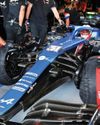
The controversies surrounding F1’s Halo have simmered down since the safety device protected Charles Leclerc when Fernando Alonso’s car was launched over the top of his cockpit at the 2018 Belgian GP, and it’s easy to see why.
‘When you watch the video frame by frame you can see the McLaren’s suspension was broken by the contact with the Halo, so with our data we have estimated it took a 56kN load, about half of what the test load is,’ said the FIA race director, the late Charlie Whiting, of the incident at the time. ‘It stood up really well and there was no distortion. Sauber took it off the car after the crash and thoroughly checked it but there were no cracks and no buckling.’
So the Halo proved itself early on, and it’s now time to unearth the technology behind this device; a piece of kit which can withstand 15 times the static load of a Formula 1 car and the hit of a 20kg wheel at 225km/h.
The FIA has been investigating additional frontal protection devices since 2011, ranging from a full canopy to having roll bar-like devices ahead of the car. From these early design iterations, three were pursued and developed to try and meet the initial design target of deflecting a wheel at 225km/h.
These were the Halo, the Shield, and the Aeroscreen. We are now all familiar with the three-pronged tubular titanium structure of the Halo; the shield is effectively a windscreen made from transparent polycarbonate, while the Aeroscreen hybrid consists of structural carbon and transparent polycarbonate.
The Halo effect
Esta historia es de la edición Anatomy of a Racecar de Racecar Engineering.
Comience su prueba gratuita de Magzter GOLD de 7 días para acceder a miles de historias premium seleccionadas y a más de 9,000 revistas y periódicos.
Ya eres suscriptor ? Conectar
Esta historia es de la edición Anatomy of a Racecar de Racecar Engineering.
Comience su prueba gratuita de Magzter GOLD de 7 días para acceder a miles de historias premium seleccionadas y a más de 9,000 revistas y periódicos.
Ya eres suscriptor? Conectar
Talk the torque
More thoughts on in-wheel motors and their effects on twisting force
Rolling about
An explanation of the limitations of a previous load transfer article, bringing jacking forces into the mix
F1 breaks schedule records
The FIA has confirmed no fewer than 23 races on the 2022 Formula 1 World Championship schedule, the highest number of grands prix ever to be held in a single season, and that has led to criticism from some teams that will be on the road for eight months.

Under pressure
Toyota may have finished first and second at Le Mans this year, but the effort required to overcome a fuel delivery problem and finish with both cars was Herculean
Physics at work
Dutch company, Intrax, offers Racecar Engineering an insight into the technologies it employs to optimise its suspension products
Williams' 2030 ambition
Williams Racing has committed to becoming climate positive by 2030 as part of an all-new sustainability strategy.
Diff'rent strokes
Racecar looks at the different types of mechanical differential, their benefits and limitations
Das Boot
A curious Twitter exchange fired up a unique, hydrogen-powered, cross-country project that will contest the Baja 1000 in November 2022

Air born
Every racecar engineer's dream is a blank sheet of paper design. When Hoonigan and Subaru approached Vermont Sportscars about building the next generation of Gymkhana racer, that's just what the company was given

Remote control
Called variously ‘virtual garages’, ‘mission control’ or ‘race support rooms’ is the future of race engineering sitting in the warm back at HQ?